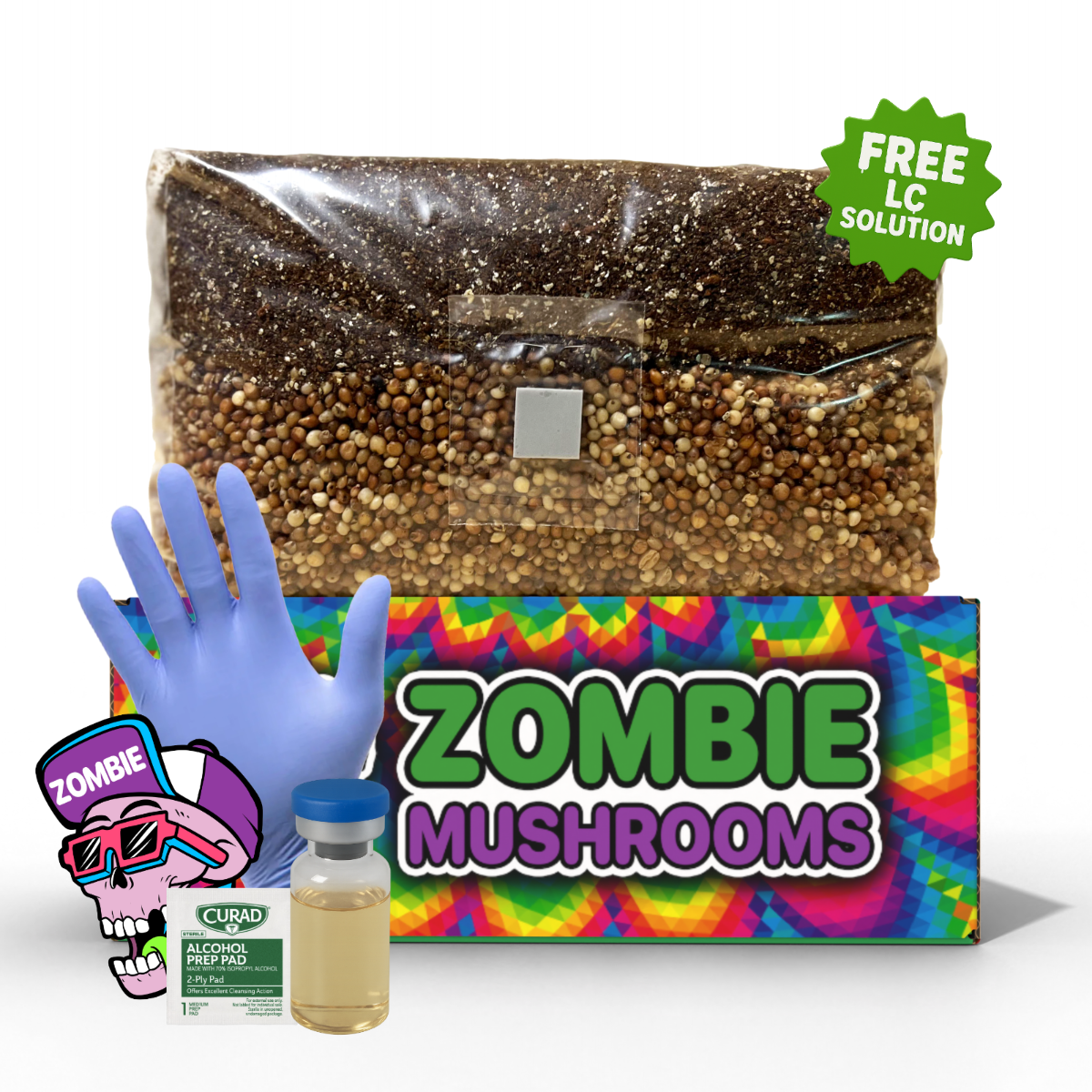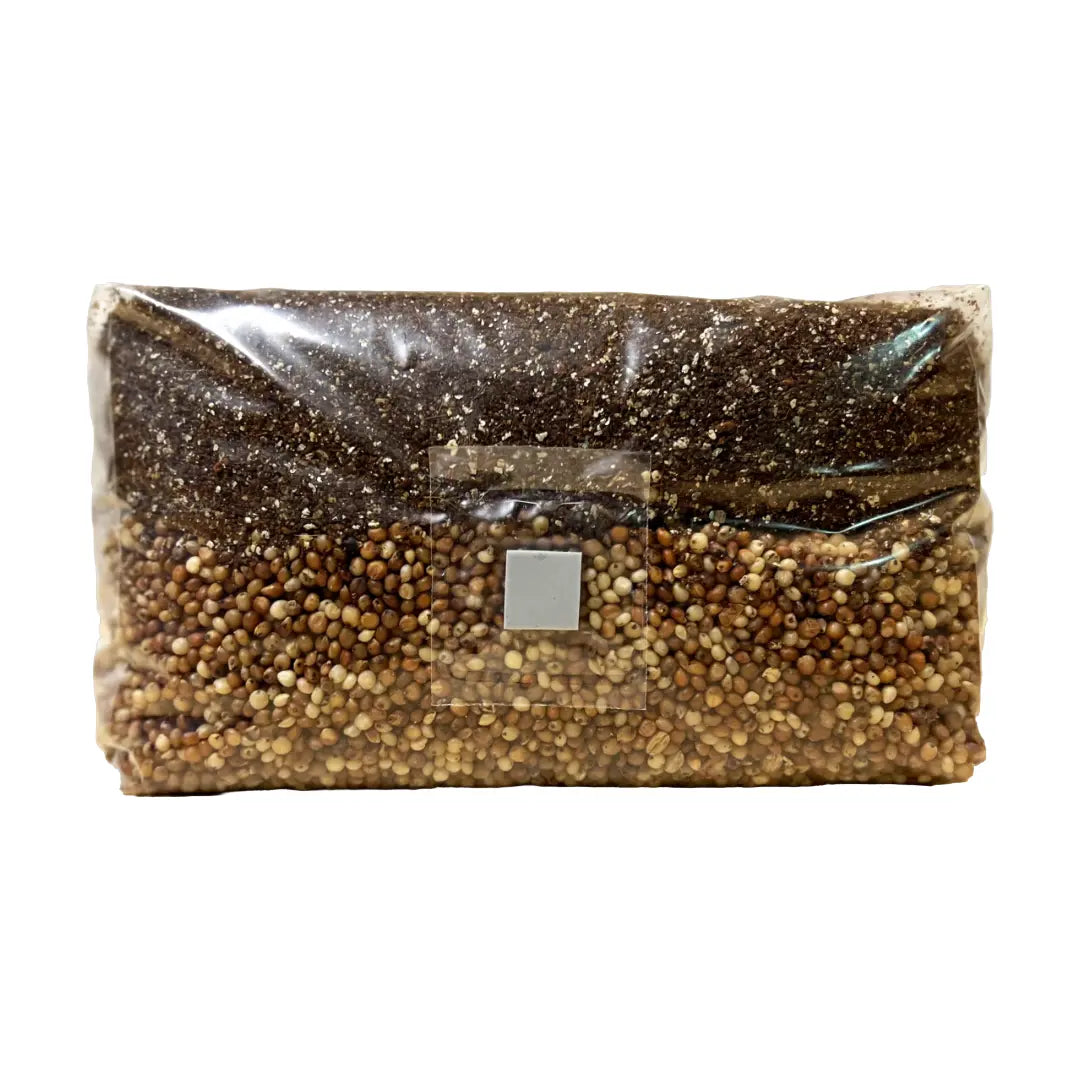⬇️ Prefer to listen instead? ⬇️

- Mushroom mycelium contains beta-glucans shown to increase NK cell activity and support immune response.
- Studies confirm compounds from mycelium improve cognitive and nervous system function, particularly in Lion’s Mane.
- Mycelium offers consistent cultivation and broader diversity of compounds compared to fruiting body in supplements.
- Daily intake of mycelium-derived beta-glucans improved immune function by up to 30% in a clinical study.
- Mycelium is being developed into eco-friendly materials like packaging, leather alternatives, and building insulation.
Mushroom mycelium is the living network of hyphae beneath the soil or substrate—the part that powers growth, nutrient cycling, and much of the bioactive content found in healthy mushrooms. Rich in beta-glucans, antioxidant compounds, and immune-boosting enzymes, mycelium is featured widely in modern supplements. For home growers, using mushroom grow bags gives you a clean, reliable way to cultivate mycelium without needing fancy lab gear. This article explores how mycelium grows, why it’s beneficial (versus just using the fruiting body), how to cultivate it properly, and what to look for in quality mycelium-derived supplements.
What Is Mushroom Mycelium?
Mushroom mycelium is the root-like structure of a fungus. While many people know the cap-and-stem part of a mushroom — called the fruiting body — the mycelium is actually most of a fungus’s life. It's made of thin threads called hyphae. Mycelium spreads out beneath the ground, inside logs, or throughout other organic materials. Think of it as the engine under the hood: you don't see it, but it's very important.
This network takes in nutrients from the environment. It does this by sending out enzymes that break down organic matter. As it spreads, mushroom mycelium can stretch over large areas, connecting with plant roots. It can also help plants talk about their nutrient needs and fight off diseases. Mycelium doesn't just help the fungus make new mushrooms — it keeps ecosystems going.
A Quick Science Breakdown: How Mycelium Works
Mushroom mycelium acts like both a cleanup system and a communication network. Here’s how
- Decomposition: Mycelium sends out strong enzymes. These break down dead plants, leaves, wood, and even some pollutants. This puts important nutrients back into the soil.
- Nutrient Cycling: Mycelium helps move nitrogen, phosphorus, and other minerals plants need to grow. In many cases, it puts more nutrients back into the soil than it uses.
- Mycorrhizal Symbiosis: Many types of mycelium form helpful partnerships with plant roots. This link, called mycorrhiza, helps both things — mycelium gets sugar from the plant's photosynthesis, and the plant gets better access to water and tiny nutrients.
- Communication Networks: Sometimes called the “Wood Wide Web,” mycelial networks help plants talk to each other. Scientists have found that some plants send chemical signals through these fungal links. These signals can warn nearby plants about danger or pests.
This special way of working has made mycelium a subject of a lot of interest in environmental science, farming, and healthcare.

How to Cultivate Mycelium at Home
If you want to grow mushroom mycelium at home — maybe for supplements, cooking, or to help the environment — growing it can be rewarding and teach you things. Here's a step-by-step guide
-
Start with a Culture
You need to begin with mushroom cultures. These usually come as- Agar plates with mycelium growing on them
-
Liquid cultures with mycelial threads in them
You can often get these from places that sell mycology supplies or from good kits.
-
Put it into Grain Spawn
The culture goes into clean grain like rye, oat, millet, or brown rice. This “grain spawn” helps the mycelium grow larger before you move it to the final growing material. -
Get the Substrate Ready and Add the Spawn
After the grain is fully covered by mycelium, you mix it into a larger material that has nutrients. Common choices include- Hardwood sawdust or wood chips
- Coconut coir and vermiculite
- Straw (often cleaned first to stop other things from growing)
- Coffee grounds (often used instead of throwing them away)
-
Keep Everything Clean
Getting dirty stuff in can ruin the process. Use -
Control Temperature and Humidity
Keep the right temperature and humidity for the type of mushroom. Usually, this means- 70–75°F (21–24°C)
- Humidity above 85%
- Low but steady airflow and indirect light
-
Wait for Mycelium to Cover the Material
Over 2–4 weeks, the mycelium will spread across the material. Once it covers everything, you might need to make small changes to the environment (like making it cooler or adding more air) to make some types of mushrooms grow caps and stems.
Growing mushroom mycelium can be a start for making your own immune support supplements or culinary mushrooms.

Zombie Mushrooms: Mycology Kits for Easy Mycelium Cultivation
For those looking to make it easier than trying it all yourself with home lab cleaning, companies like Zombie Mushrooms offer ready-to-use mycology kits. These kits are good for beginners and include
- Clean material ready to use
- Grain spawn or liquid culture with mycelium
- Grow bags with filters
- Guides and tools
Zombie Mushrooms’ grow kits are made for specific species. They offer options like
- Oyster Mushrooms: Grow fast and have lots of nutrients
- Lion’s Mane: Popular for helping the brain
- Reishi Mushrooms: Used to help balance the immune system
These kits let you grow mushroom mycelium and fruiting bodies safely at home. If you want immune help, you can start taking mycelium extracts or teas after it covers everything, with very little cleaning or equipment needed.
Why Mushroom Mycelium Is Key in Immune Support Supplements
Why it works so well in mushroom mycelium is because it has a lot of active compounds that help control how your immune system works. Research has found that mycelium makes many substances that make it helpful in immune support supplements
- Beta-glucans: Complex substances shown to activate immune cells like macrophages, dendritic cells, and natural killer (NK) cells.
- Triterpenoids: Compounds that fight swelling and viruses, found most often in Ganoderma (Reishi).
- Antioxidants: Compounds that protect immune cells from damage caused by unstable molecules.
- Polysaccharopeptides (PSP/PSK): Found in Turkey Tail, these compounds have been studied a lot for helping balance the immune system and even used along with cancer treatments.
According to Simoncini, Genchi, & Gasperi (2018), beta-glucans from mushroom mycelium make more immune cells and help them react better — so they react faster to germs and make the whole immune system work better.
Compared to man-made immune support supplements, mushroom-derived options work in a whole-body way and have fewer side effects.

Popular Mycelium Species in Supplements
Not all mushrooms give the same health benefits when it comes to health uses. Here are some of the most studied and widely used species whose mycelium is taken for supplements
Reishi (Ganoderma lucidum)
- Known as the “Mushroom of Immortality” in old Chinese medicine.
- Has lots of triterpenoids and ganoderic acids.
- Shown to fight swelling, protect the liver, and help the body handle stress.
Turkey Tail (Trametes versicolor)
- Easy to spot with its colorful, fan shape.
- Has polysaccharopeptides used in Japan along with cancer treatments.
Lion’s Mane (Hericium erinaceus)
- Helps the growth of new nerve cells and mental clarity.
- Has hericenones and erinacines that affect Nerve Growth Factor (NGF).
Cordyceps (Cordyceps militaris)
- Used in the past to make breathing, kidney, and sexual function better.
- Increases ATP production, helping with performance and energy.
Mycelium from these fungi has the main active compounds like the fruiting body. It also has other things made during growth, which can sometimes offer more benefits.
Mycelium vs. Fruiting Body: Which One to Use (or Both)
People still talk about whether to use mycelium or fruiting body in supplements. This is mainly because they are grown differently and have different nutrients. According to Urbach (2020)
- Fruiting Body Advantages: Often richer in certain compounds like triterpenoids; traditional herbal sources tend to emphasize fruit bodies since they’re more visible and have historical usage.
- Mycelium’s Strengths: Easier to cultivate year-round indoors; often yields higher biomass sooner; may contain a broader spectrum of enzymes and polysaccharides thanks to growth on nutrient substrates.
- Best Practices: For supplemental value, many high-quality products use both mycelium and fruiting body to capture full spectrum benefits. Always check lab reports or certificates to verify content (e.g. how much of each is present).
To get all the benefits, full-spectrum mushroom supplements are often suggested. These use both mycelium and fruiting body.

Extraction and Formulation: How Supplements Use Mycelium
To get the health effects they want, companies use different ways to pull out key compounds from mycelium
-
Hot Water Extraction
Works best for getting out beta-glucans that dissolve in water. Often used in older Chinese methods, like boiling mushrooms. -
Ethanol or Dual Extraction
Needed to get out triterpenoids and sterols, which don't dissolve in water. Dual extraction costs more but gives more benefits.
Once the parts are taken out, the material is
- Put into supplement pills
- Made into powder for smoothies or drinks
- Mixed into tinctures and oils for under the tongue use
How good a product is can differ. Always look for
- Organic certification of the source
- Extracts tested in labs with known beta-glucan content
- Clear labels showing how much is fruiting body vs. mycelium

Scientific Evidence Behind Mycelium's Health Benefits
More and more science shows that mushroom mycelium helps the immune system
- Vetvicka & Vetvickova (2014) found that taking beta-glucans from mycelium daily made immune response better by up to 30%. This was seen in macrophage and NK cell activity.
- Other lab studies have shown that polysaccharide-bound peptides (PSP) can fight viruses. They showed they stopped influenza and HIV viruses from copying themselves.
- Lion’s Mane mycelium looks promising in early studies for making symptoms of mild cognitive problems less bad. It might help slow down Alzheimer's.
- Help balancing the immune system has also been seen in people with cancer. It helped during chemo and made white blood cells come back faster.
We still need more human studies to be sure how well they work for everyone. But the first results show they could help with many health problems.
The Future of Fungal Health: Beyond Supplements
Mushroom mycelium may start in health, but can be used in almost endless ways
- Sustainable Packaging: Grown into custom shapes to take the place of plastic foam made from oil.
- Fungal Leather: Companies like MycoWorks are making mycelium into leather that breaks down naturally.
- Construction Materials: Myco-bricks that don't burn easily, keep heat in, and fight mold are being looked at for building homes in ways that are better for the planet.
- Soil Regeneration: Mycelium is being put into farm soil to make it healthy again where the helpful tiny life is gone and to help capture carbon.
These new ideas show how mushroom mycelium works: it changes easily, it fixes things, and it connects deeply.

FAQ
-
What is mushroom mycelium and why is it used in supplements?
Mycelium is the network of fungal hyphae that does much of the organism’s nutrient absorption and biochemical activity. It’s used in supplements because it often contains immune-active compounds (beta-glucans, enzymes) and is easier to grow in large quantities than fruiting bodies. -
Can I grow mycelium at home easily?
Yes—with some basic tools: starter culture (agar or LC), sterilized substrate or grain spawn, clean workspace, and environmental control (temperature, humidity). Mushroom grow bags help simplify many of these steps. -
Is there a difference in benefits between mycelium-only vs fruiting body supplements?
Yes. Fruiting bodies often have unique compounds (like triterpenoids), while mycelium may give more enzymes or broader bioactive content depending on substrate. Full-spectrum supplements use both to get a more complete profile. -
Are there any risks or concerns with mycelium use?
Risks include contamination, quality control (heavy metals or toxins if substrate is contaminated), incorrect species, or misleading labeling. Always use reputable sources and lab-tested supplements or cultivate cleanly. -
How long does it take for mycelium to grow to usable quantity?
Depending on species and substrate, substantial mycelial growth can occur in 2-4 weeks after inoculation under good conditions. Scaling to supplement or extract quality may take longer.
How to Get Started Growing Mycelium Today
Want to try growing it yourself? Here’s how to begin
- Buy a Starter Kit: Zombie Mushrooms has beginner kits with simple guides, clean equipment, and species that grow fast.
- Join Online Communities: Sites like r/mycology or forums such as Shroomery.org are great places to get advice from others.
- Keep track of what you do: Take photos, write notes, and learn from each time you grow. Mistakes are part of the growth process—literally.
Growing mushroom mycelium not only makes you feel more connected to nature, but it also lets you get fresh, strong immune help right in your own kitchen.
Closing Thoughts: Nature’s Healing Network
Mushroom mycelium connects trees, makes ecosystems healthy, and now helps our immune systems. As a force of nature that heals soil and bodies, mycelium offers real solutions based on how nature works. Whether you're taking supplements for a strong immune system or growing your own cultures, you're part of a global mycelial movement. This movement brings together old knowledge with modern science.
Want to start growing mycelium? Zombie Mushrooms offers good quality grow kits that make growing functional mushrooms easy.
Citations
- Simoncini, M., Genchi, G., & Gasperi, V. (2018). Bioactive compounds in mushroom mycelium and their effects on immune function. International Journal of Medicinal Mushrooms, 20(3), 215–228.
- Vetvicka, V., & Vetvickova, J. (2014). Immune enhancing effects of mushroom-derived compounds. Journal of Dietary Supplements, 11(4), 361–375.
- Urbach, S. (2020). Fruiting body vs. mycelium in medicinal mushroom supplements. Journal of Functional Foods and Fungi, 2(1), 45–53.



